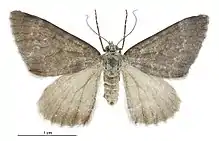Helastia clandestina
Helastia clandestina is a moth of the family Geometridae. This species is endemic to New Zealand and is found only in the South Island in and around Arthur's Pass. Adults have been collected on the wing in February and are nocturnal. Its preferred habitat is dry stony riverbeds and flood plains. The glossy blueish grey colouration of the adults of this species helps camouflage them against the rocks in their preferred habitat. H. clandestina is classified as having the conservation status of "At Risk, Relict'" by the Department of Conservation.
| Helastia clandestina | |
|---|---|
 | |
| Female | |
 | |
| Male | |
| Scientific classification | |
| Domain: | Eukaryota |
| Kingdom: | Animalia |
| Phylum: | Arthropoda |
| Class: | Insecta |
| Order: | Lepidoptera |
| Family: | Geometridae |
| Genus: | Helastia |
| Species: | H. clandestina |
| Binomial name | |
| Helastia clandestina | |
| Synonyms[2] | |
| |
Taxonomy
This species was first described by Alfred Philpott in 1921 using a specimen collected by E.S. Gourlay at Arthur's Pass and named Xanthorhoe clandestina.[3][2] George Hudson discussed and illustrated this species in his 1928 book The Butterflies and Moths of New Zealand under the same name.[4] In 1987 Robin C. Craw placed this species within the genus Helastia.[5] The holotype specimen is held at the Canterbury Museum.[2]
Description
.jpg.webp)
Philpott described the species as follows:
♂︎. 35 mm. Head and palpi grey-whitish. Eyes olive-brown. Antennae dark grey, pectinations 5 but appearing shorter owing to being basally appressed to the shaft. Thorax grey. Abdomen whitish-grey. Fore-wings elongate-triangular, costa sinuate, apex bluntly pointed, termen straight, oblique ; bluish-grey ; lines faintly indicated in darker ; an irregular basal line at 1⁄6 ; first line at 1⁄3, double, slightly waved ; discal spot rather elongate, transverse, dark ; a fairly straight, slightly waved, median line ; second line from 2⁄3 costa to 3⁄4 dorsum, excurved on upper half, faintly margined with white on veins : cilia white, basally mixed with grey. Hindwings grey, slightly darker round termen : cilia white.[3]
The glossy blueish grey colouration of the adults of this species helps camouflage them against rocks.[6]
Distribution
This species is endemic to New Zealand.[7][1] It occurs in Westland, North Canterbury and Mid Canterbury.[8]
Biology and lifecycle
Very little is known about the biology of H. clandestina.[9] Hudson records it being on the wing in February.[4] Adult moths are nocturnal.[5]
Host species and habitat

The host species for the larvae of H. clandestina is unknown.[8] H. clandestina prefers stony riverbed habitat such as at the Waimakariri River flood plain.[8][9]
Conservation status
This moth is classified under the New Zealand Threat Classification system as being "At Risk, Relict".[10]
References
- "Helastia clandestina (Philpott, 1921)". www.nzor.org.nz. Landcare Research New Zealand Ltd. Retrieved 2018-05-16.
- Dugdale, J. S. (1988). "Lepidoptera - annotated catalogue, and keys to family-group taxa" (PDF). Fauna of New Zealand. 14: 181. Retrieved 15 May 2018.
- Philpott, Alfred (1921). "Notes and descriptions of New Zealand Lepidoptera". Transactions and Proceedings of the New Zealand Institute. 53: 337–342. Retrieved 16 May 2018.
- Hudson, G. V. (1928). The Butterflies and Moths of New Zealand. Wellington: Ferguson & Osborn Ltd. p. 113.
- Craw, R. C. (1987). "Revision of the genus Helastia sensu stricto with description of a new genus (Lepidoptera: Geometridae: Larentiinae)". New Zealand Journal of Zoology. 14 (2): 269–293. doi:10.1080/03014223.1987.10422997.
- Buckley, Thomas R.; Hoare, Robert J. B.; Leschen, Richard A. B. (2022-10-09). "Key questions on the evolution and biogeography of New Zealand alpine insects". Journal of the Royal Society of New Zealand: 1–25. doi:10.1080/03036758.2022.2130367. ISSN 0303-6758.
- Gordon, Dennis P., ed. (2010). New Zealand inventory of biodiversity: Kingdom animalia : chaetognatha, ecdysozoa, ichnofossils. Vol. 2. p. 459. ISBN 978-1-877257-93-3. OCLC 973607714. OL 25288394M. Wikidata Q45922947.
- Patrick, Brian; Dugdale, John S. (2000). Conservation status of the New Zealand lepidoptera (PDF). Wellington, N.Z.: Department of Conservation, New Zealand. p. 24. ISBN 978-0478218671. OCLC 154670803.
- Pawson, S.M.; Emberson, R.M. (2000). "The conservation status of invertebrates in Canterbury" (PDF). Conservation Advisory Science Notes. 320: 1–64.
- Hoare, R.J.B.; Dugdale, J.S.; Edwards, E.D.; Gibbs, G.W.; Patrick, B.H.; Hitchmough, R.A.; Rolfe, J.R. (2017). Conservation status of New Zealand butterflies and moths (Lepidoptera), 2015 (PDF). Wellington, New Zealand: New Zealand Department of Conservation. p. 7. ISBN 9781988514383.
